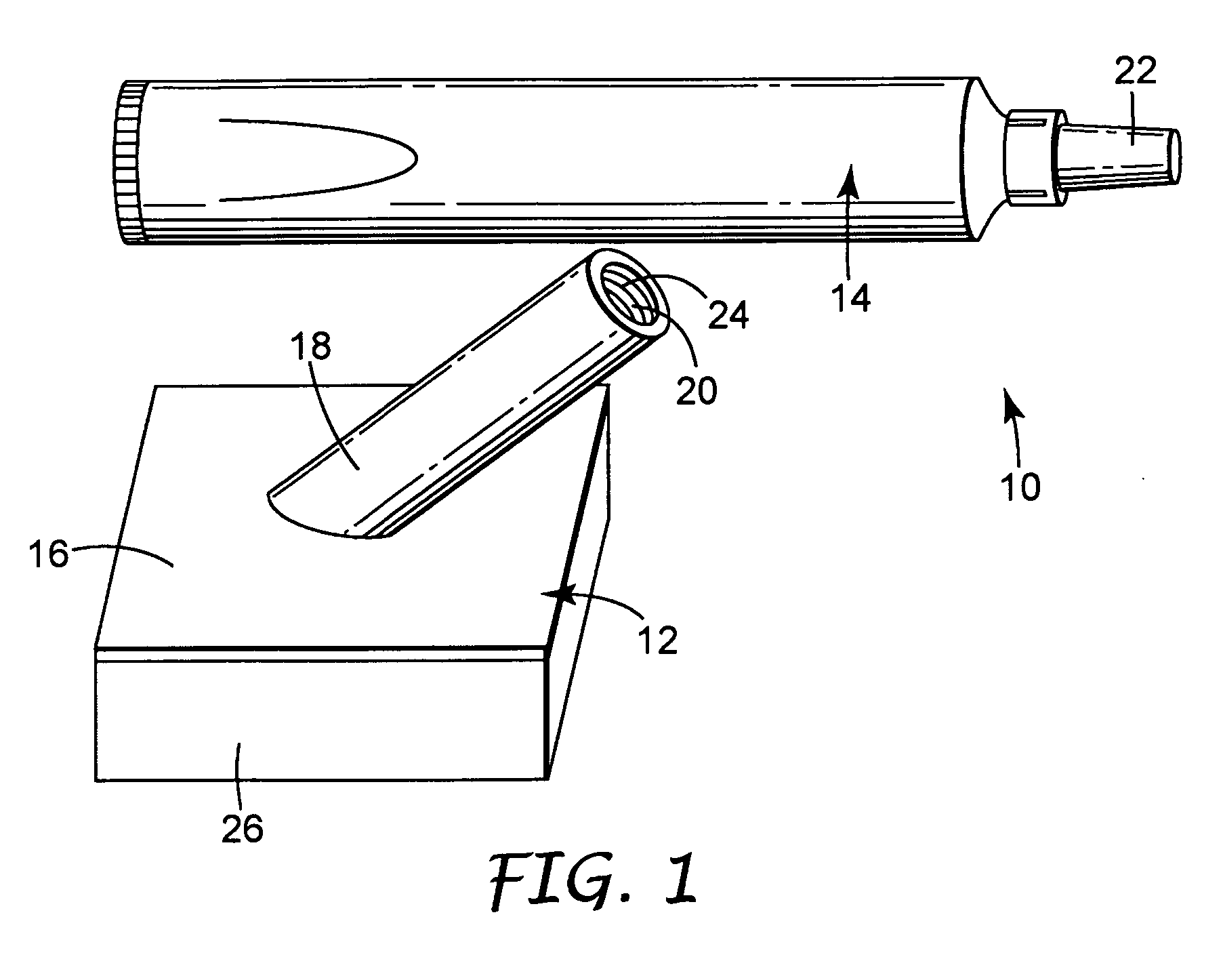Surgical prep solution applicator system and methods
a technology of applicators and solutions, applied in the field of liquid applicators, can solve the problems of affecting the effect of the application, the dripping of the solution is not easy to control, and the technique is messy and offer,
- Summary
- Abstract
- Description
- Claims
- Application Information
AI Technical Summary
Benefits of technology
Problems solved by technology
Method used
Image
Examples
example 1
[0071] A body generally as depicted in the drawing was machined from two pieces of Delrin plastic such that the stem extended away from the rest of the body at an angle of about 45 degrees. The main plane of the body was approximately 5 cm by 5 cm, and the stem was about 4.8 cm in length. The stem was threaded to accept complementary threads on the container element. Distribution channels were machined into the bottom surface of the body by end milling 0.29 cm diameter grooves in the body in such a way as to create a eight individual paths from the center of the body nearly to its edge. The artisan will perceive that injection molding will be a preferred method of fabricating the body in quantity, and that other polymers, such as polyolefins, will be suited to such manufacturing.
[0072] A foam pad, commercially available from Illbruck, Minneapolis, Minn. and identified as P 90 Z Beige Clickable foam pad was adhesively attached to the body using a hot melt adhesive. A bead of hot mel...
example 2
[0075] About 21 g of DURAPREP Surgical Solution (a hydroalcoholic solution containing 74% w / w isopropyl alcohol and 0.7% available iodine) was filled into 1 oz. Expac poly film / foil / polyfilm laminate tubes available from Expac Corp. of Hopkins, Minn., as model number 5485X. The exact weight of the tube before and after filling was recorded to 4 decimal places. The tubes were heat sealed. Two sets of 10 tubes were prepared. Set A had a foil seal welded over the tip. Set B did not. Both sets of tubes had a polycap screwed on tightly over the tip. The tubes were placed in a recirculated oven at 50° C. for 28 days. The tubes were removed periodically and weighed. The weight was recorded to four decimal places. The following results were obtained:
% Weight Loss After Aging At 50° C.Set ASet BDayMeanMean00030.03320.041970.04080.0577100.05030.0651140.05340.0782170.05710.0838210.06890.0906240.07610.1058280.090.1155
[0076] The data indicates that even after 28 days at 50° C. the mean value of...
example 3
[0077] The same tube construction used in Ex. 2 was filled with 26 g water. Ten tubes were sealed and capped without the foil cap seal. The tubes were ETO sterilized in a 3M Sterivac Model 4XL ethylene oxide sterilizer. The tubes were then aerated for one hour twenty minutes in a 3M model XL Aeratra cabinet. This results in an exposure to ethylene oxide gas for about four hours and ten minutes at 500 millibars and an aeration time of one hour and twenty minutes. The samples were sent to Biotest Labs in Minneapolis, Minnesota, for testing. The contents of the tubes by gas chromatography for residue of ethylene oxide, ethylene chlorohydrin and ethylene glycol. The presence of these compounds in the contents of the tubes would indicate that the tube allowed some of the ethylene oxide sterilant to enter the tube during the sterilization cycle.
Results
[0078] All of the containers were found to have non-detectable levels of ethylene chlorohydrin and ethylene glycol. Six of the ten Expac ...
PUM
 Login to View More
Login to View More Abstract
Description
Claims
Application Information
 Login to View More
Login to View More - R&D
- Intellectual Property
- Life Sciences
- Materials
- Tech Scout
- Unparalleled Data Quality
- Higher Quality Content
- 60% Fewer Hallucinations
Browse by: Latest US Patents, China's latest patents, Technical Efficacy Thesaurus, Application Domain, Technology Topic, Popular Technical Reports.
© 2025 PatSnap. All rights reserved.Legal|Privacy policy|Modern Slavery Act Transparency Statement|Sitemap|About US| Contact US: help@patsnap.com



